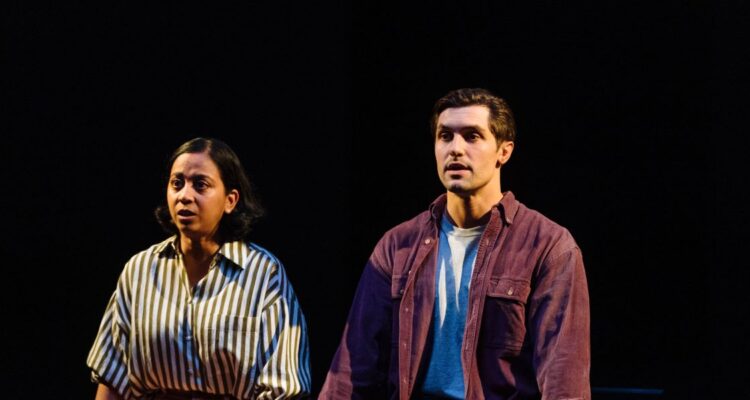What strikes you first and – ultimately – last about this show is the set and how it is used in the course of the evening. Jerwood Upstairs is configured in traverse with a steep ramp emerging from the depths, culminating in a doorway. A rectangular lighting panel hovers above and porthole lights are set into the walls behind the seating on either side. As the action begins we are in the company of a couple, Ray and Sylvia, both in their 30s, who are clearly taking us through some kind of re-enactment. This turns out to be an account of a traumatic event in which a flight to a honeymoon turns into a highjacking where each of them becomes critically involved in the outcome and its detailed aftermath.
As the play proceeds we gradually become aware in flashback of the different episodes of what actually happened and how the couple survive. There are important themes in play here that are highly topical – how do people survive calamitous events and what is the price exacted from them as they come to terms with what has happened – if they ever do? But writer Oli Forsyth takes the scenarios in some most unlikely psychological directions that often lack plausibility despite the conviction with which the actors put them across. The couple turn on each other in such rapid and convoluted ways you begin to feel that you are being manipulated so that various conflicting viewpoints can be aired irrespective of whether they emerge naturally out of the couple’s dynamic. Is it really likely that Ray would automatically feel marginalised and minimised by that fact that his wife’s role leads her to be lionised? Are Sylvia’s reactions to meeting the pilot of the plane or to the intrusive questionings of an interviewer really the most immediate responses someone would have in these circumstances? At points like this you begin to see the scaffolding in the writing rather than the heart of the matter.
That said, the scenes in which the highjacking comes to life are some of the best dramatised, thrilling and fear-inducing that I have recently experienced in a theatre. As the highjacker wrestles for the controls with the pilot and then with Sylvia we ourselves feel the vertiginous drop in elevation as the lighting panel angles more steeply, lights flash, engines scream and then cut out. Very simple means, but hugely effective and greatly to the credit of the set design, lighting and sound team of Anna Reid, Simeon Miller and Paul Arditti.
The three cast members do their best with this taxing material. As Ray, Phil Dunster plausibly represses his memories and experiences and tries to insist on explanations that place a rational framework around events. Anyana Vasan has the more demanding role, given Sylvia’s emotional journey from fear of flying through to dynamic intervention and later resort to ever widening circles of recrimination. Both the reactions and the events that provoked them lack full credibility, but that in no way diminishes the work of the actor in putting the material over. Craig Else completes the cast in a variety of roles, carefully distinguished from one another, but where the most developed is as a guilty father of a child who travelled alone on the flight, who then goes on to lead a lawsuit for compensation.
This play remains a mixed bag. The staging has huge technical merits and anyone seeking to set a drama on a plane should be taking notes. But what happens before, and especially after the central incident, seems more willed than achieved, at least in the writing.
Writer: Oli Forsyth
Director: Daniel Raggett
Cast:Phil Dunster, Craige Els, Anyana Vasan
Until 9 November 2024
90 mins no interval
Photo Credit: Helen Murray

